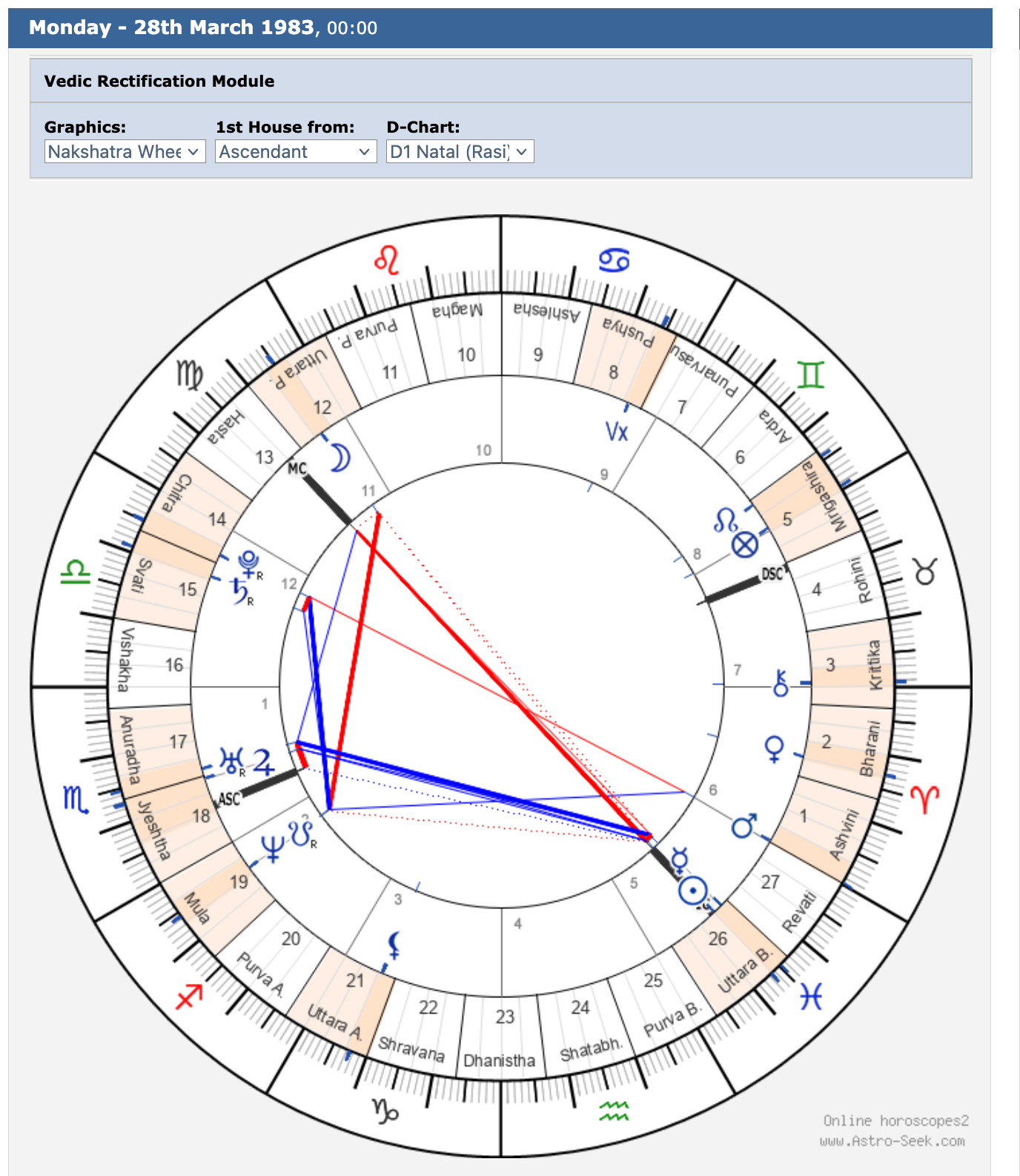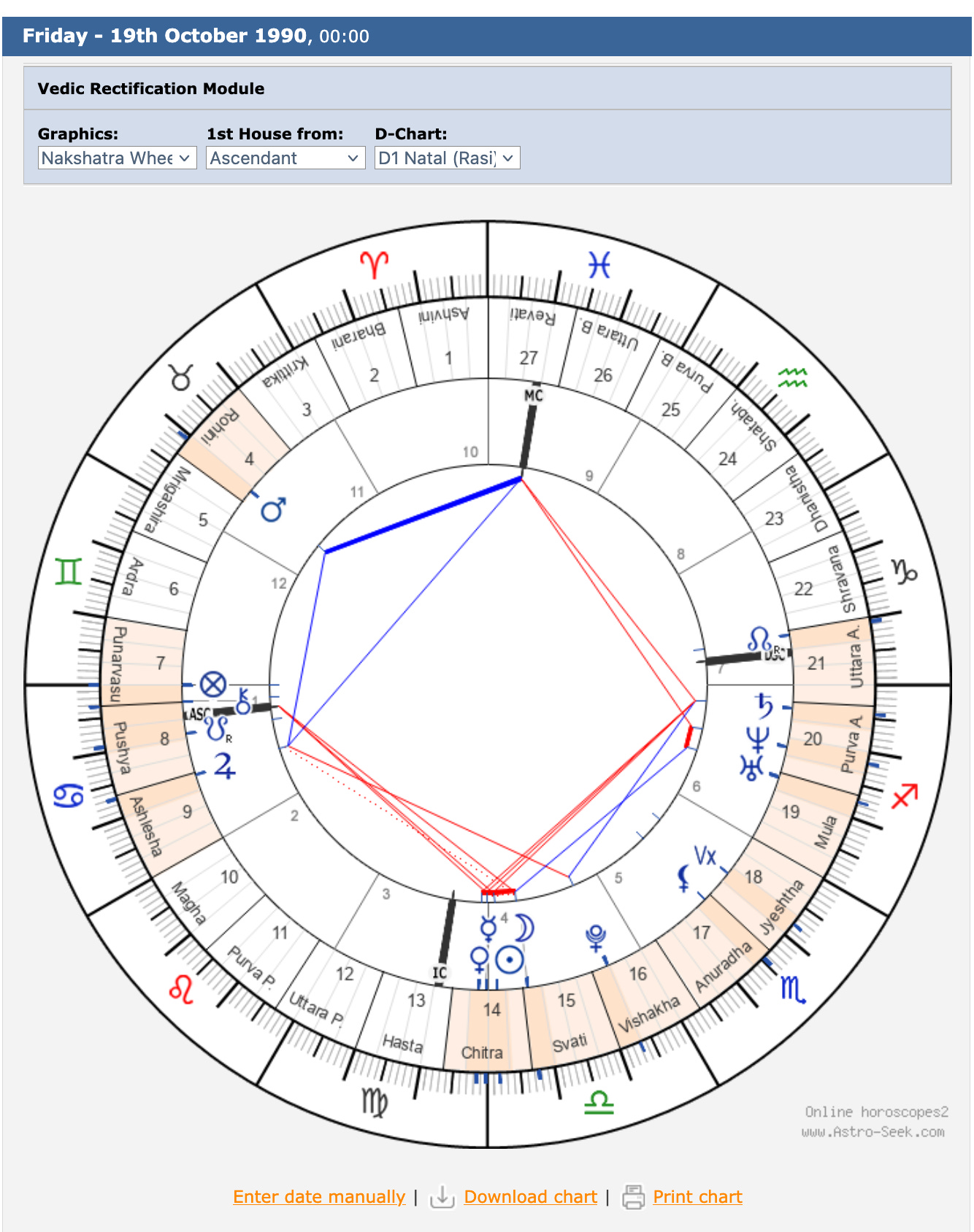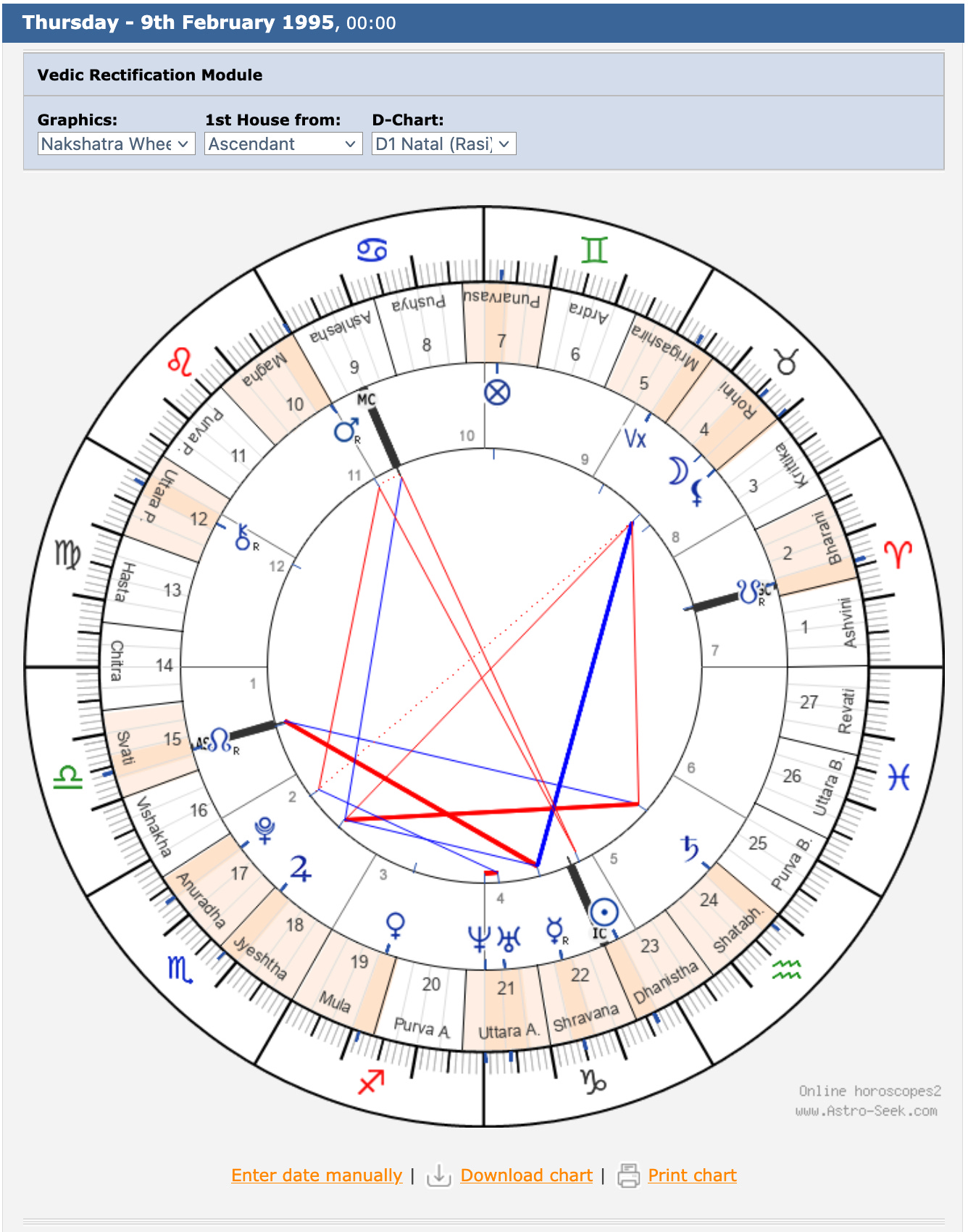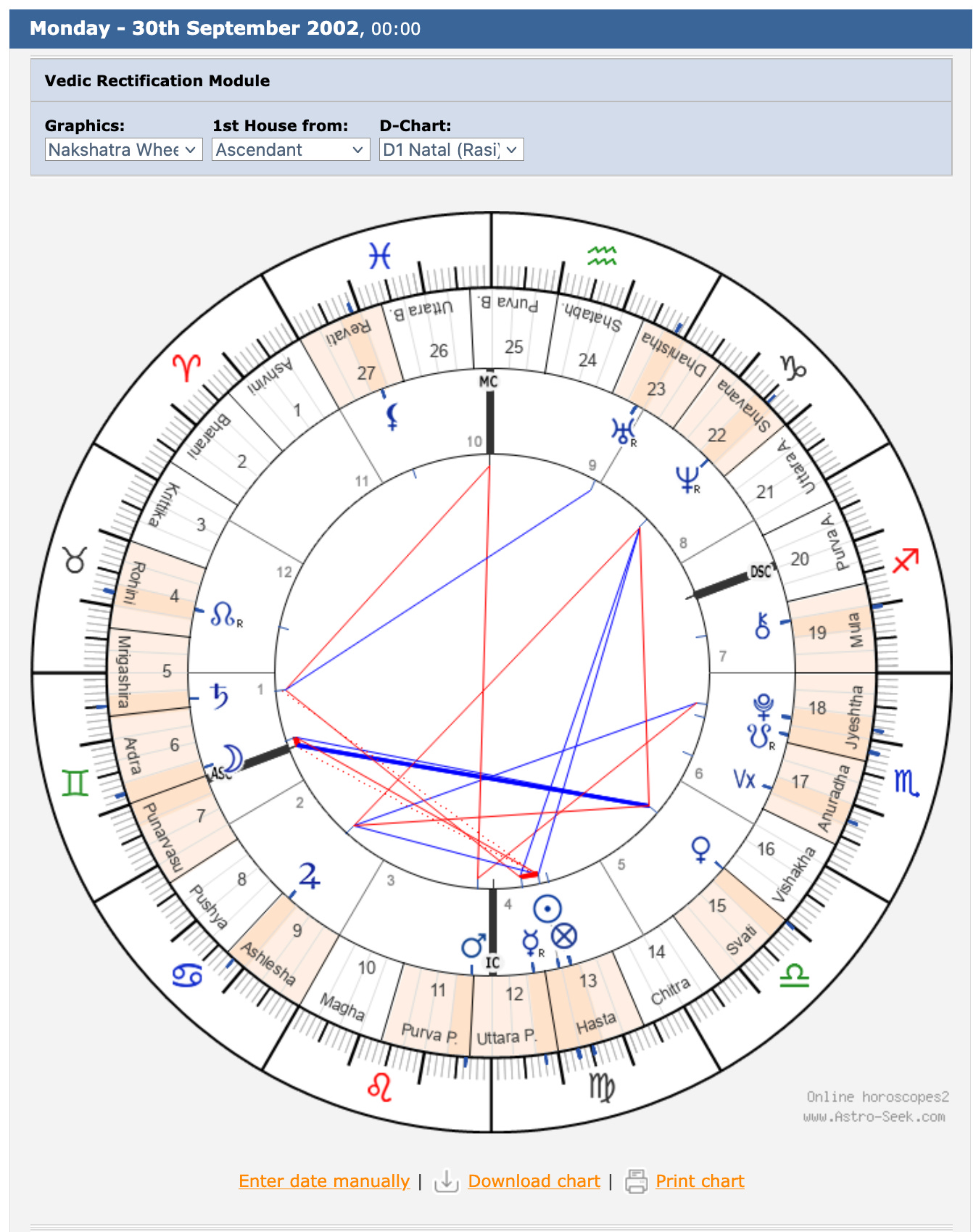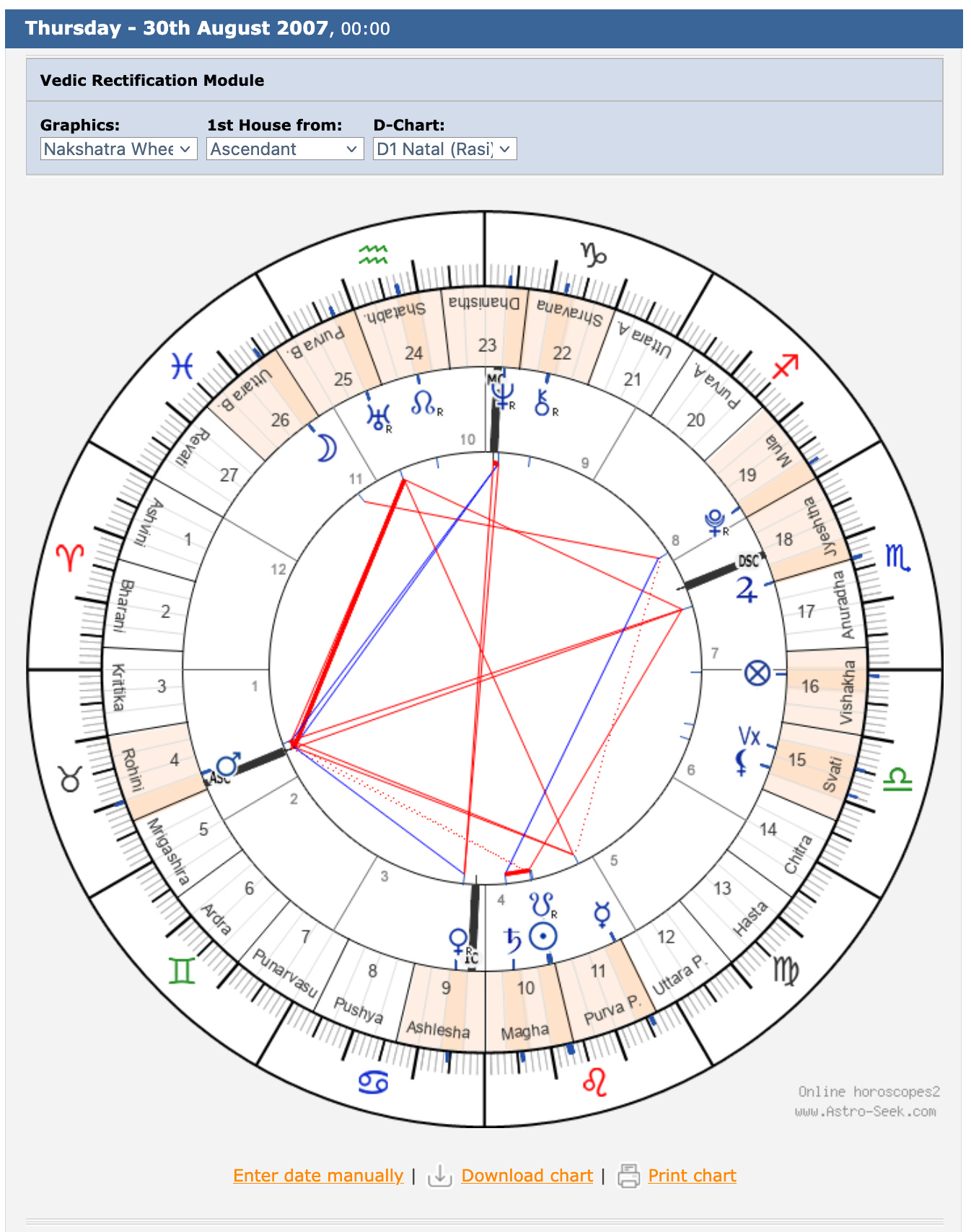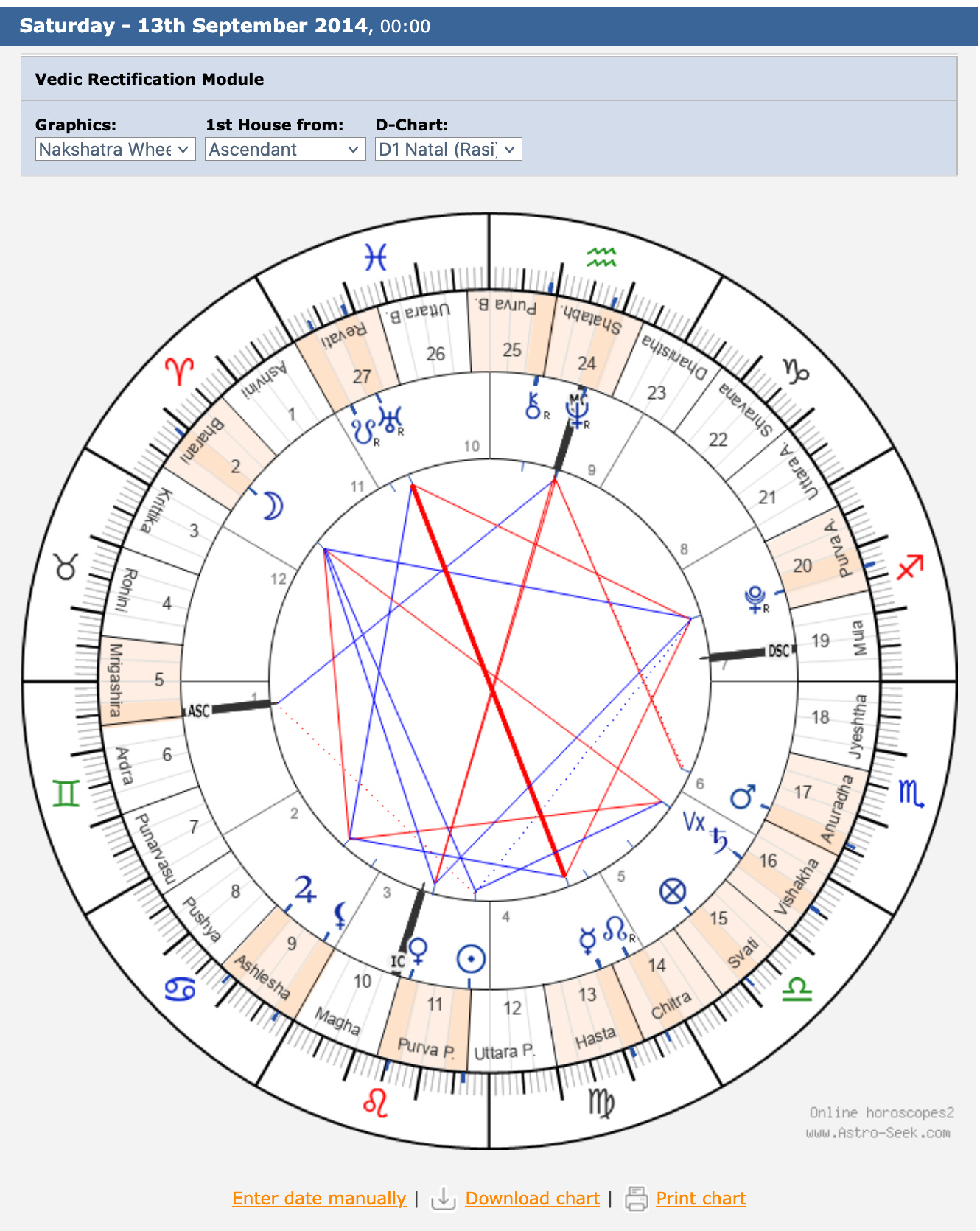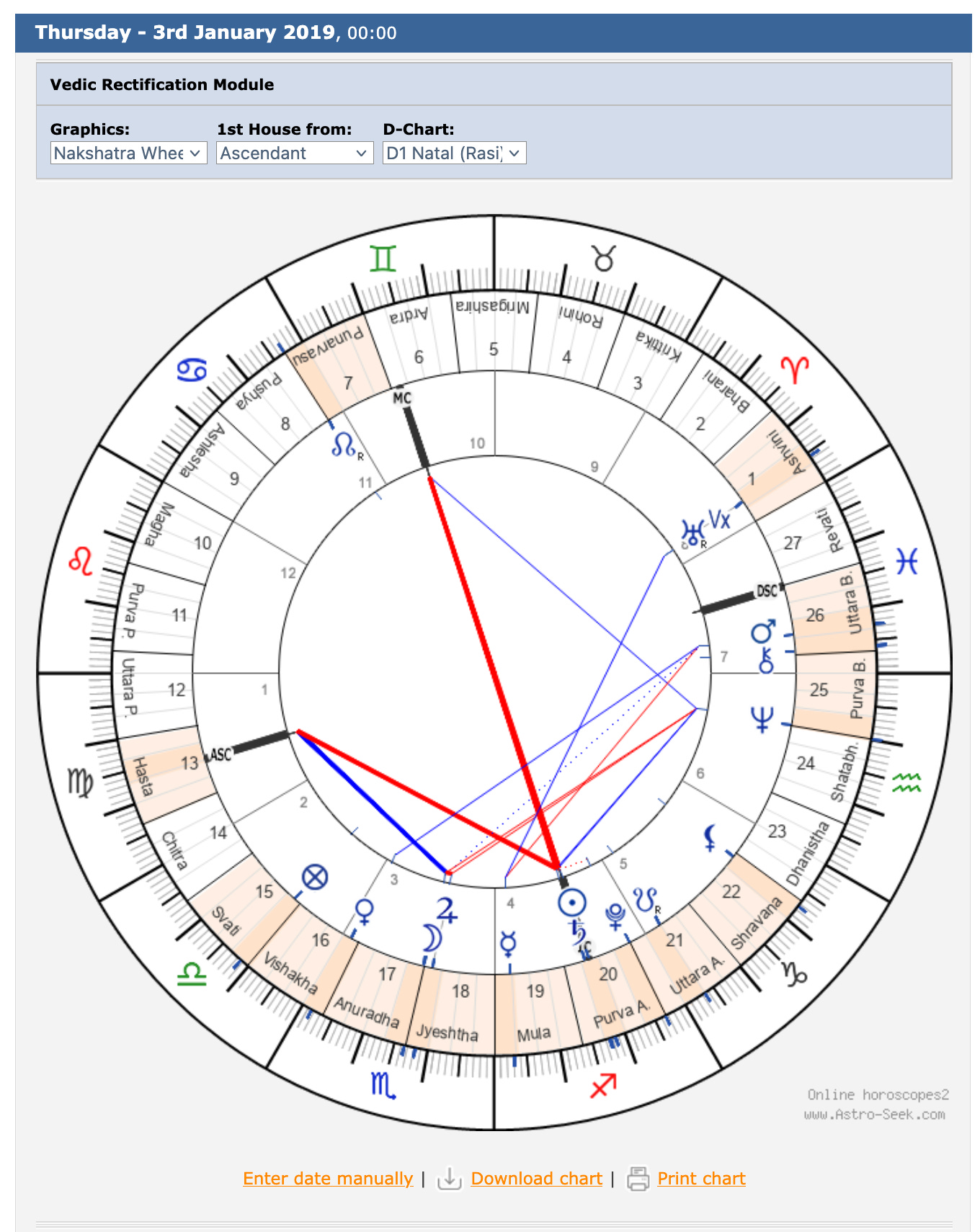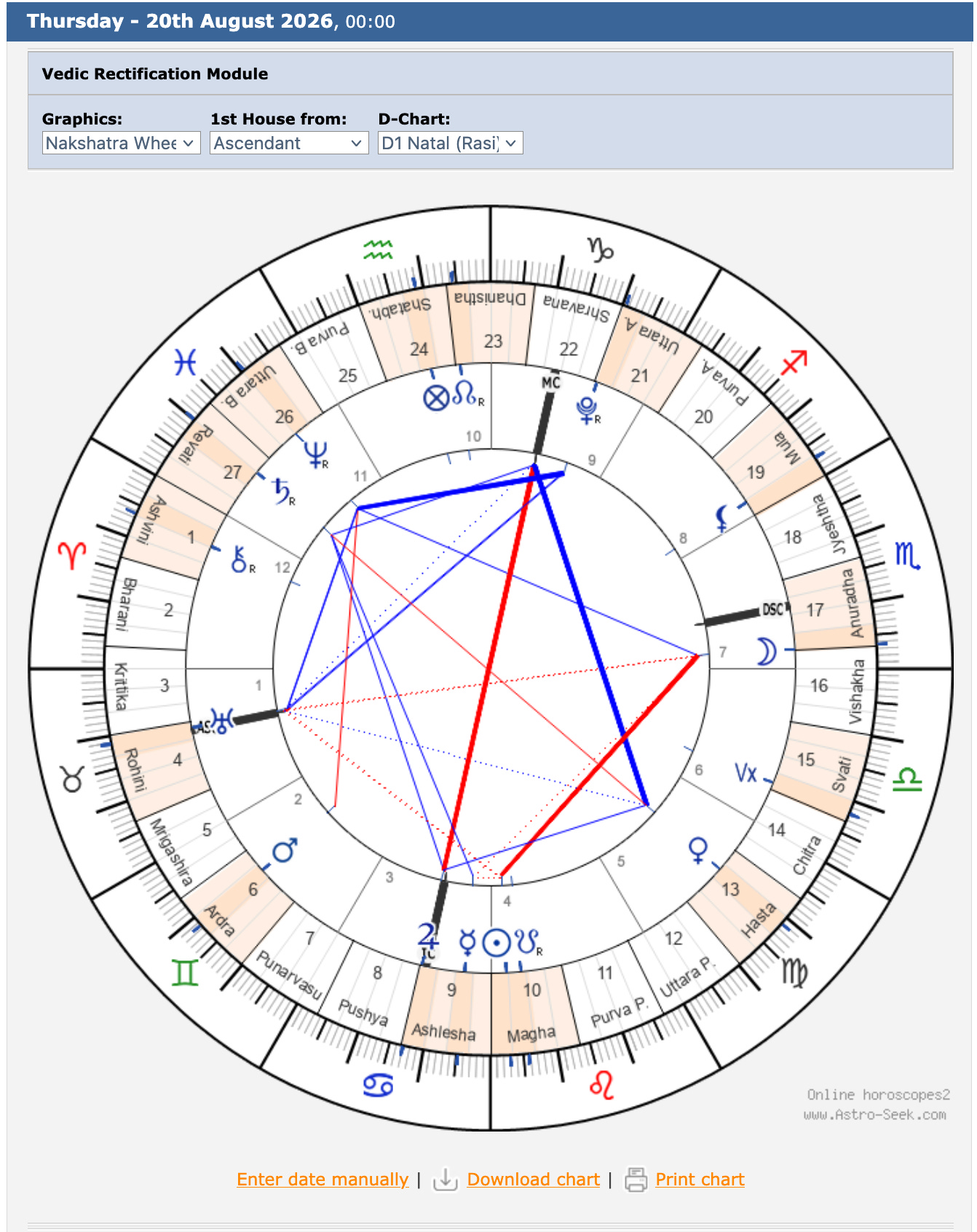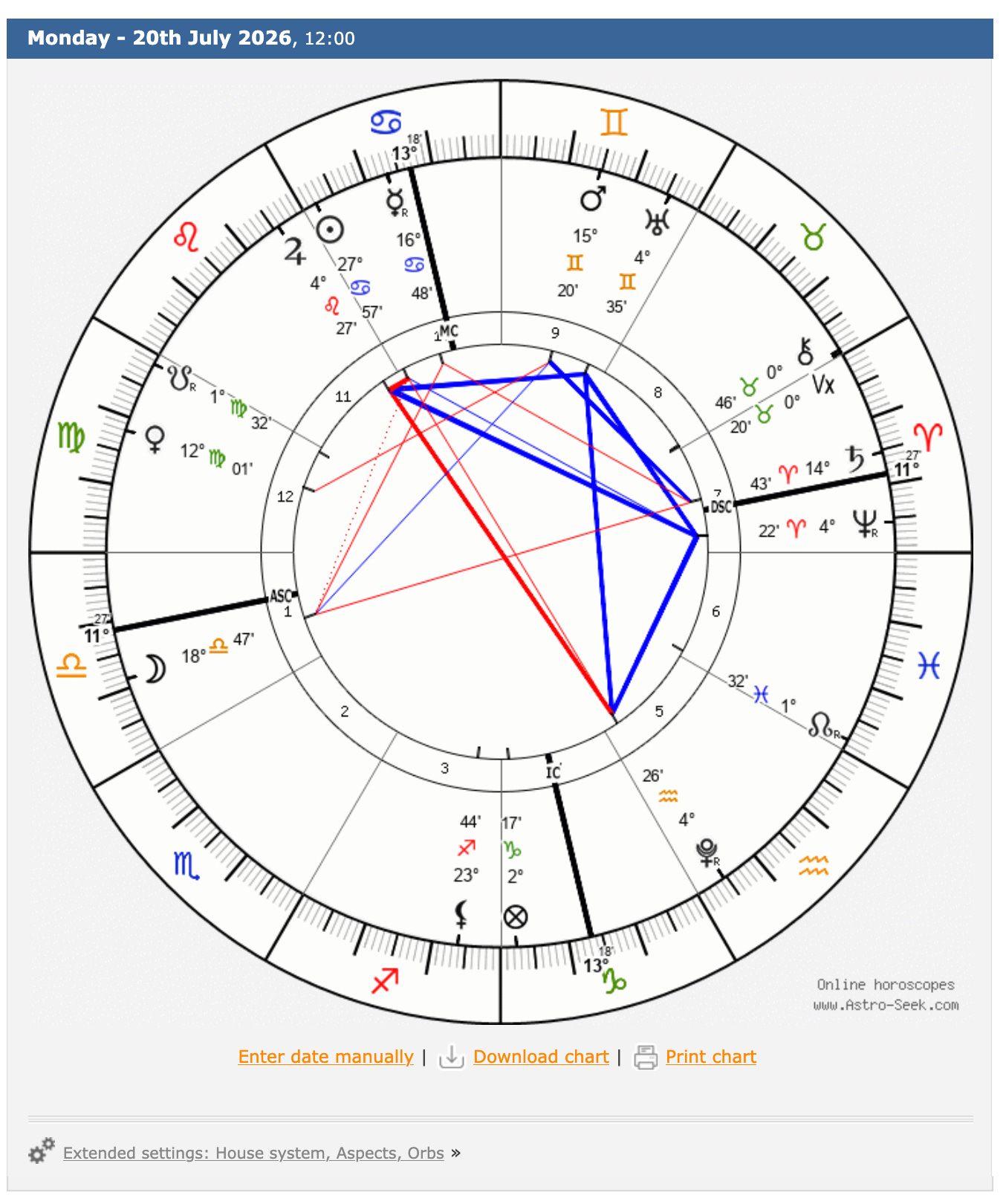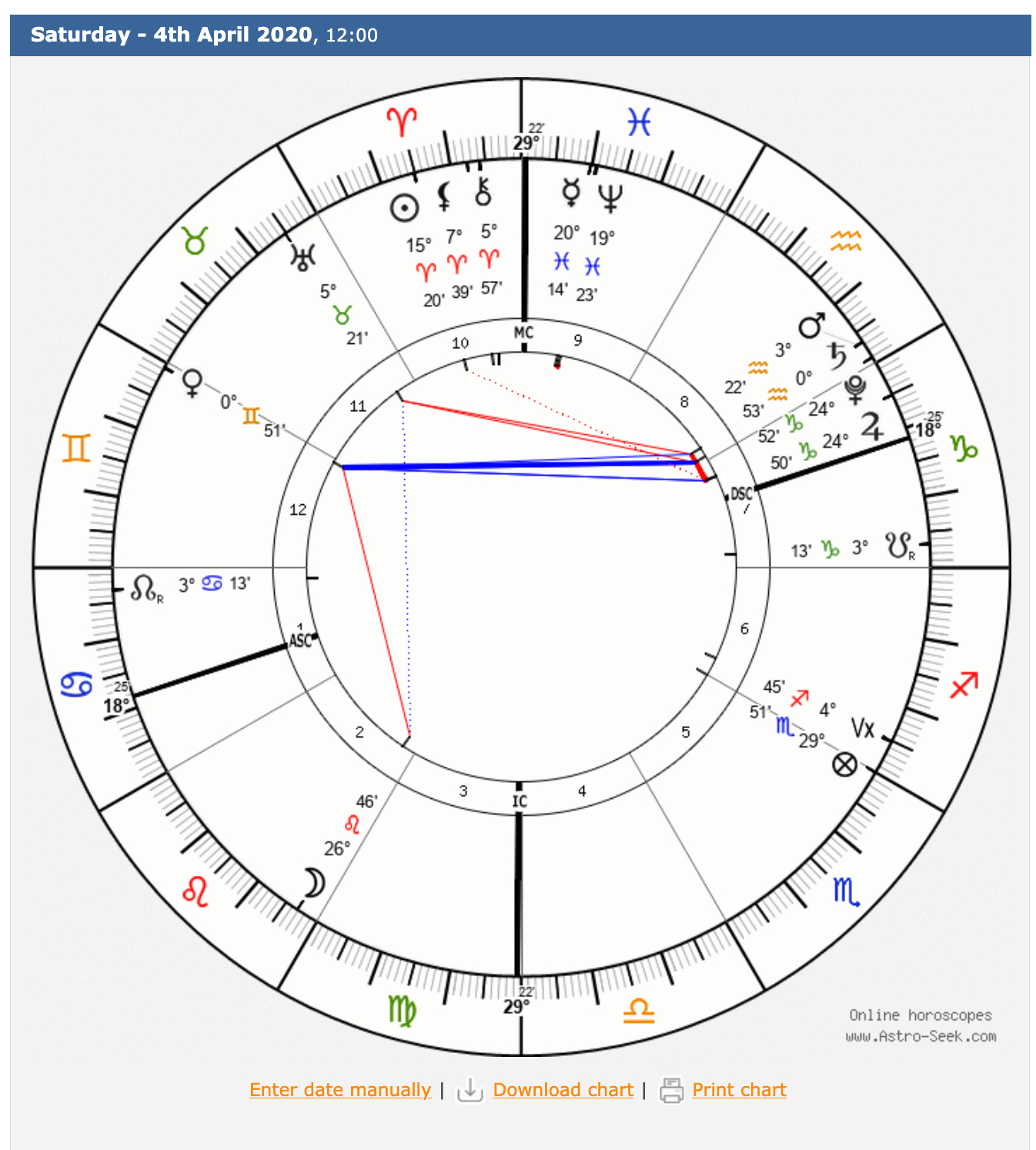The Next Global Health Crisis? Watch August 2026 Closely
Vedic Astrology Advises Financial Prudence From August 2026 onward.
I would like to begin this article by acknowledging that what follows builds upon the insights of an exceptional palmist and Jyotishi, Sulab Jain, who runs the Chariot Palmistry YouTube channel. I recently came across one of his videos where he lays out a compelling theory about why October 2026 could mark a chaotic month and a potential global crisis point. In this piece, I’ll be expanding on his framework, testing it against financial astrology methods, and exploring whether the evidence supports being especially cautious during that period.
Sulab’s theory is simple, but also strikingly original. He claims that Jupiter will create a health crisis whenever it transits the Āśleṣā and Jyeṣṭhā Nakshatras.
Āśleṣā is one of the most serpentine and intense Nakshatras in the zodiac. Its ruling deities are the Nagas, the serpent gods, giving it a coiled, hidden, transformative energy. It carries associations with mystery, psychology, and Kundalini or the “serpent power” waiting to rise. It’s not hard to see why ancient seers connected this Nakshatra to both hidden wisdom and sudden upheaval.
Jyeṣṭhā, by contrast, is a Nakshatra of seniority and authority. It bestows power, responsibility, and mastery over challenges, often carrying lessons about pride, ethical use of strength, and the burdens of leadership.
According to Sulab, when Jupiter passes through these two Nakshatras, health crises tend to emerge. His observation goes even further: these crises tend to fall into a 12-year rhythm, with two distinct viral events appearing in sequence. The first comes, then after an 8-year gap, another arises, and then 4 years later, a new outbreak follows. This creates a repeating pattern of epidemic or pandemic emergence.
Backtesting the Health Crisis Theory
1978 - H1N1 Influenza A
The H1N1 Influenza A virus re-emerged in 1977, spreading globally through 1978 and causing epidemic-level illness mostly among children and young adults. The key years here are 1977, when it reappeared, and 1978, when transmission peaked worldwide.
At this time, Jupiter was not in Āśleṣā but was transiting Ardra, Punarvasu, and Pushya. It only entered Āśleṣā in July 1979. By then, the epidemic had already peaked and was in decline, though there were still ongoing cases into that summer.
What does this tell us? It suggests Jupiter in Āśleṣā may not always mark the beginning of a viral outbreak but could align with its climax or turning point. The timing of the 1977–79 H1N1 epidemic shows that Jupiter’s influence may come in at the height of impact, rather than at the initial spark.
1983 - HIV/AIDS
Four years after Jupiter entered Āśleṣā (1979), we see the emergence of AIDS as Jupiter enters Jyeshta. Early cases were developing by 1982, but it wasn’t until 1983 that the crisis entered the public consciousness. In January 1983, UCSF opened Ward 86, the world’s first outpatient AIDS clinic, and Ward 5B for inpatient care. By March, the U.S. Public Health Service had issued blood donor screening guidelines, identifying high-risk groups. On May 20th, 1983, the retrovirus causing AIDS (later named HIV) was officially identified by scientists at the Pasteur Institute in Paris.
Astrologically, this lines up with Jupiter entering Jyeṣṭhā Nakshatra in March 1983. The timing is exact; the emergence of AIDS as a defined global health crisis coincided with Jupiter’s shift into this Nakshatra. However, unlike with the H1N1 case, Jupiter’s transit here seems to mark the start of the epidemic, not the peak. And importantly, it didn’t end when Jupiter left Jyeṣṭhā in December 1983; the crisis continued to escalate well beyond that.
1990 - Cholera Outbreak
Seven years later (not the exact eight years Sulab’s theory mentions, but close enough to count), Jupiter entered Āśleṣā Nakshatra in late October 1990. At first, there wasn’t an immediate event, but just three months later, in January 1991, a massive cholera outbreak erupted in Peru. From there, it spread rapidly across Latin America, hitting Ecuador, Brazil, Colombia, and Mexico. Between 1991 and 1994, the outbreak led to over 1 million reported cases and nearly 10,000 deaths, making it one of the largest cholera epidemics in the Western Hemisphere in modern history.
The timing isn’t exact to the day, but it is strikingly close. Jupiter’s entry into Āśleṣā marked the opening of the window, and within months the crisis fully unfolded. That keeps Sulab’s model intact, with Jupiter in Āśleṣā once again coinciding with a major epidemic.
1995 - AIDS, Flu, Malaria
Jupiter re-entered Jyeṣṭhā in February 1995. This was five years after the previous crisis in 1990, not four, but still within Sulab’s broad cycle. Sulab mentions malaria, TB, and cholera here, but when we look at the actual data, the dominant health crisis of 1995 was still AIDS. By that year, AIDS had become the leading cause of death for Americans aged 25 to 44 and continued to spread worldwide, infecting millions. In scale and severity, it dwarfed other outbreaks of that year.
Yes, there were other events such as the Ebola outbreak in Kikwit, Zaire (deadly, but affecting hundreds rather than millions), localised epidemics of cholera, malaria, and tuberculosis, and even severe flu epidemics in Russia and Ukraine. But none of these matched the sheer global weight of HIV/AIDS in 1995. So this case is a partial hit. Jupiter’s transit into Jyeṣṭhā didn’t mark the start of something new this time but instead amplified a pre-existing crisis that was already near its global peak.
2002 - SARS
Seven years later (again, not the neat 8 years Sulab suggests), Jupiter entered Āśleṣā in 2002. The defining health crisis of that year was the emergence of Severe Acute Respiratory Syndrome (SARS), which first appeared in November 2002 in Guangdong, China. By early 2003, it had spread globally, with over 8,000 cases across 29 countries. Jupiter left Āśleṣā in September 2003, and interestingly, that exit coincides almost exactly with the effective end of the SARS epidemic.
2007 - Swine Flu
Five years later (again, not the clean 4-year cycle), Jupiter entered Jyeṣṭhā. Around 2007, there were swine-origin influenza outbreaks, like in the Philippines, but they stayed localised and never spread across continents. The 2007–2008 flu season saw the usual mix of influenza A (H1N1, H3N2) and influenza B, with some swine-related strains, but nothing beyond typical seasonal flu. The real “global” swine flu crisis didn’t break out until 2009, when a novel H1N1 virus emerged and spread rapidly, forcing the WHO to issue a Phase 6 pandemic alert by June that year. By then, Jupiter was in Dhanishta Nakshatra. So in my view, 2007 wasn’t a miss, but also not a global threat, more of a prelude.
2014 - Ebola
7 Years after the 2007 initial swine flu outbreaks (again, 7, not 8), Jupiter entered Āśleṣā in late September 2014.
The biggest health crisis in late September 2014 was the West African Ebola epidemic, the largest and most complex outbreak of Ebola virus disease in history. Ebola spread to Italy, Mali, Nigeria, Senegal, Spain, the United Kingdom, and the United States and caused over 11,300 deaths worldwide. This is an accurate hit of Jupiter in Āśleṣā
2019 - Covid-19
Five years after the 2014 Ebola outbreak (five, not four), Jupiter entered Jyestha Nakshatra. We all remember the COVID-19 pandemic in vivid detail. But here’s the catch this theory doesn’t account for: COVID-19 only entered public consciousness around March 2020, when lockdowns began. Jupiter had actually entered Jyestha in January 2019 and left by November 2019, months before the pandemic became a global concern. In reality, no significant health crisis was apparent until early 2020. By February 2024, Jupiter was in Purva Ashadha Nakshatra. So, in terms of timing, this transit seems off by a full year, which I’m classifying as a clear failure of the theory.
2026 - A New Health Crisis Emerges?
Seven years after Jupiter entered Jyestha in 2019 brings us to 2026. By late August 2026, Jupiter will enter Ashlesha Nakshatra. Sulab predicts that a new health crisis could occur sometime between August 2026 and January 2027.
Reviewing the Data So Far
We see that this theory is strong but far from perfect. There’s definitely a strong correlation, but we also see that there can be delays from when Jupiter enters these Nakshatras vs when they become a real issue in the public consciousness. However, there’s still a strong link here. There is also variability in the virality and strength of the virus - some epidemics were huge and global, such as Aids, some were more contained, such as the blend of viruses in 1995.
Looking at the actual gaps between events:
1979 → 1983: 4 years ✓
1983 → 1990: 7 years (theory says 8)
1990 → 1995: 5 years (theory says 4)
1995 → 2002: 7 years (theory says 8)
2002 → 2007: 5 years (theory says 4)
2007 → 2014: 7 years (theory says 8)
2014 → 2019: 5 years (theory says 4)
The pattern is consistently off by 1 year from the predicted 4/8 cycle. The actual pattern appears to be closer to a 5-year/7-year alternation rather than 4/8. However, if we allow ±1 year margin of error, the theory works.
We also see that the theory doesn’t nail down whether the entrance of Jupiter into these Nakshatras marks the start of the health crisis, the middle or the end.
In terms of the severity of the pandemic, I also notice that Jupiter in Jyestha transits so far correlate with the most devastating pandemics in modern history (HIV/AIDS and COVID-19), while Jupiter in Ashlesha transits correlate with more contained, regional outbreaks, although still deadly. In 2026, we are due for an Ashlesha transit.
Ashlesha crisis events averaged 6-18 months in duration. Jyestha's crisis events were multi-year.
Overall, there is 100% accuracy in predicting some “significant” health event within ±1 year of the transit. There’s also the risk of confirmation bias: major health events occur frequently, so finding some crisis near any date is likely.
What Will We See in August 2026?
On July 20th 2026, we see a Jupiter-Pluto opposition. This usually heralds very tough events, the archetype of positivity being in the hardest aspect, an opposition, to the planet of crisis, death and rebirth. This is part of the synodic cycle, which started with the Jupiter-Pluto conjunction in April 2020, just as lockdowns were coming in and COVID was spreading. Rahu will also enter Aquarius by August 2026. Rahu can cause problems in the air element of Aquarius. If we go back to July 2009, we also saw Rahu entering Aquarius. This is when the Swine Flu really became a global issue. In terms of ranking among health crises of the last 10-15 years, the 2009 swine flu caused fewer deaths than the COVID-19 pandemic, but was one of the more severe flu pandemics in recent history.
Based on astrology and currently available health data, I believe the most likely scenario is the emergence of an Avian Influenza H5N1 (Bird Flu) epidemic between August and December 2026. This timeframe represents a “start date” when the virus could begin spreading. H5N1 is the virus with the highest likelihood of emerging next, as we are still due a significant “natural” epidemic or pandemic following 2020. The August-to-January window also aligns with winter months, when viruses tend to be more virulent.
There is reason for concern. While the COVID-19 fatality rate was around 1%, H5N1 historically has a mortality rate of approximately 50–52%. The first U.S. death from H5N1 has already occurred, and early samples indicate the virus is beginning to adapt for more efficient human-to-human transmission. Scientists believe H5N1 is increasingly moving into human populations. However, pandemic preparedness has improved significantly since 2020, and I expect a swift response and regional containment, which should mitigate the worst-case outcomes despite the virus’s historically high mortality rate.
What Does This Mean For Your Money?
Even a 5% mortality rate could likely trigger lockdowns, and the economic consequences could surpass those of the COVID-19 crash.
How can we prepare? We need to keep an eye out for August 2026. If we hear anything in the news, even rumours, about Bird Flu or a similar pandemic, take your investments off the table for a little while or put them into Gold immediately.
From a purely economic perspective, if these events unfold as projected, we may see a COVID-19 crash-type scenario. On the bright side, any market crashes happening in Q4 2026 could represent a once-in-a-lifetime buying opportunity.
Conclusion: Beware of August-December 2026
Sulab Jain’s Nakshatra-based health crisis theory is far from perfect, but the historical record shows a surprisingly consistent pattern: Jupiter’s transits through Āśleṣā and Jyeṣṭhā often coincide with significant epidemics or pandemics, even if the timing varies by a few months or at maximum a year. The correlation is strong enough to warrant attention, especially given that August 2026 sees Jupiter in Ashlesha, A Pluto-Jupiter Opposition, and Rahu entering Aquarius.
Based on both astrological patterns and contemporary health data, the most plausible scenario for August–December 2026 is the emergence of an Avian Influenza H5N1 outbreak. While the historical fatality rate of H5N1 is high, improved pandemic preparedness and rapid containment efforts could mitigate the worst-case outcomes. Nonetheless, even a moderate mortality rate could trigger lockdowns and major economic disruption, making this a period to watch closely.
Investors and traders would be wise to monitor these signals from August 2026 onwards. Maintain flexibility, and consider protective measures such as moving money into gold or holding it as cash. From a market perspective, any crisis-induced downturn could also create excellent buying opportunities.
In short, while the precise timing and severity remain uncertain, the combination of Sulab’s Nakshatra theory, synodic cycles, and historical patterns suggests that August 2026 through early 2027 is an alarming period. Anticipate, observe, and act prudently.
Om Shanti,
Rowan
Disclaimer: This is not financial advice. The author is not a financial advisor. This astrological analysis is for educational purposes only. Cryptocurrency investments are highly risky and speculative. Always do your own research and consult qualified professionals before making investment decisions. Astrology is an indicative model and does not claim causation.


